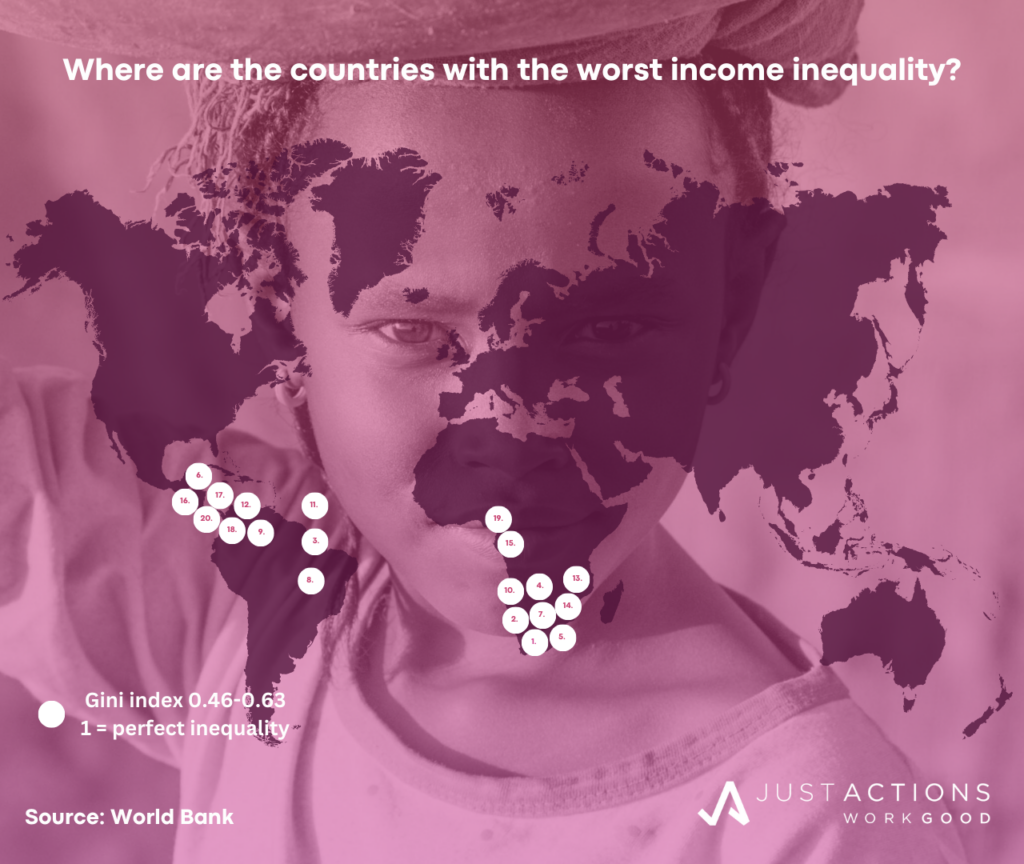Why are the poorest countries the most unequal?
The world is finally talking about income inequality, but the conversation is very much focused on the rising inequality within rich countries, especially in the USA and Europe. A lesser known, but very important, feature of income inequality is that the countries with the widest gaps are not the richest, but the poorest. Only one of the 20 countries with the highest levels of income inequality measured by the Gini Index, is classified as high-income by the World Bank – Panama. In contrast, 11 are classified as low or lower middle-income and eight are upper middle -income.
The Gini score ranges from 0, perfect equality where everyone receives an equal share of national income, to 1, perfect inequality, where only one recipient receives all the income. If we map the 20 countries with the highest income inequality, it is immediately clear that inequality not only clusters in Sub-Saharan Africa and Latin America and the Caribbean, but that it is further concentrated in specific areas within these regions (see chart).
In the case of Africa, income inequality is clustered in the south – in South Africa (1),* Eswatini (5), Botswana (7), Namibia (2), Angola (10), Zambia(4), Zimbabwe (14) and Mozambique (13)- and central west – Congo (15) and Cameroon (19). In Latin America and the Caribbean, income inequality clusters in the Central American corridor in Belize (6), Honduras (17), Guatemala (16), Nicaragua (20), Costa Rica (18), and Panama (12), and then travels into South America through Suriname (3), Colombia (9), Brazil (8), and St Lucia (11). All of these countries have Gini scores above 46. The USA, by comparison, scores 39.8.
*Countries listed in order of income inequality, highest to lowest.
Why should income inequality be so much worse in these countries? Are there common features that predispose them to income inequality and trap them there? Does inequality leak across borders under certain conditions, creating regional clusters of inequality? Most of the countries with the worst income inequality do share certain features including heavy reliance on a single export commodity (often a natural resource), a colonial history as subjects of the Spanish, Portuguese, Dutch, German, and British, and low levels of human development. However, they also vary in terms of their levels of democracy, corruption, and gender equality.
What is most likely is that a toxic cocktail of factors is responsible for sustaining extreme income inequality in countries with a long history of exploitation by foreign entities, including lack of export diversity, low levels of investment in health and education, high gender inequality, dysfunctional tax and transfer systems, and heavy reliance on foreign investment or aid. In countries where elites have captured the levers of power, these factors are hard to change as wealth is passed easily from one generation to the next and may even spread to elites across borders, contributing to the regional clustering of extreme income inequality.
IT ALL STARTS WITH A PUBLIC COMMITMENT TO “SHARED PROSPERITY”
If the countries affected are looking for a shortlist of investments to reverse inequality, they should start with a commitment to “shared prosperity” and set a new national target of increasing the share of national income owned by the bottom 40% to at least 25% by 2030.
How to get there?
Generous investments in health and education, jobs growth, technology adoption, and taxation and social policy reforms that disproportionately benefit children and youth from the bottom 40% of households can reverse inequality. Over the long-term, export diversification and reduced dependence on foreign aid could create a more competitive economy that is more resistant to the monopoly rents that sustain domestic elites. In other words, less dependence on foreign aid could turn out to be an important ingredient in the drive to reduce domestic income inequality for this group of countries.
Updated January 2024



